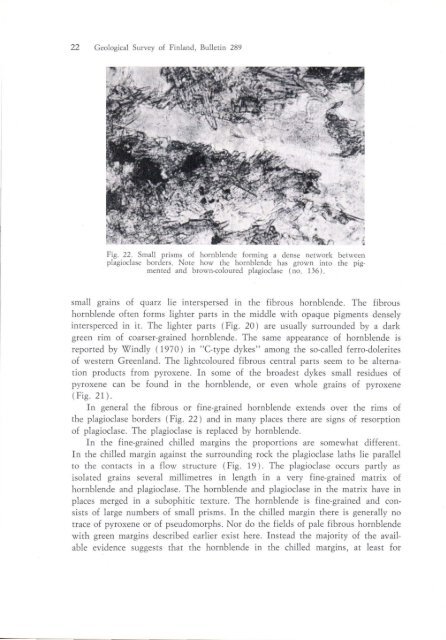Geological Survey of Finland Bulletin 289 - arkisto.gsf.fi
Geological Survey of Finland Bulletin 289 - arkisto.gsf.fi
Geological Survey of Finland Bulletin 289 - arkisto.gsf.fi
You also want an ePaper? Increase the reach of your titles
YUMPU automatically turns print PDFs into web optimized ePapers that Google loves.
22 <strong>Geological</strong> <strong>Survey</strong> <strong>of</strong> <strong>Finland</strong>, <strong>Bulletin</strong> <strong>289</strong><br />
Fig. 22. Small prisms <strong>of</strong> hornblende forming a dense network between<br />
plagioclase borders. Note how the hornblende has grown into the pigmented<br />
and brown-coloured plagioclase (no. 136).<br />
sm all grains <strong>of</strong> quarz lie interspersed in the <strong>fi</strong>brous hornblende. The <strong>fi</strong>brous<br />
hornblende <strong>of</strong>ten forms lighter parts in the middle with opaque pigments densely<br />
intersperced in it. The lighter parts (Fig. 20) are usually surrounded by a dark<br />
green rim <strong>of</strong> coarser-grained hornblende. The same appearance <strong>of</strong> hornblende is<br />
reported by Windly (1970) in "C-type dykes" among the so-called ferro-dolerites<br />
<strong>of</strong> western Greenland. The lightcoloured <strong>fi</strong>brous central parts seem to be alternation<br />
products from pyroxene. In some <strong>of</strong> the broadest dykes small residues <strong>of</strong><br />
pyroxene can be found in the hornblende, or even whole grains <strong>of</strong> pyroxene<br />
(Fig.21).<br />
In general the <strong>fi</strong>brous or <strong>fi</strong>ne-grained hornblende extends over the rims <strong>of</strong><br />
the plagioclase borders (Fig. 22) and in many places there are signs <strong>of</strong> resorption<br />
<strong>of</strong> plagioclase. The plagioclase is replaced by hornblende.<br />
In the <strong>fi</strong>ne-grained chilled margins the proportions are somewhat different.<br />
In the chilled margin against the surrounding rock the plagioclase laths He parallel<br />
to the contacts in a flow structure (Fig. 19). The plagioclase occurs partly as<br />
isolated grains several millimetres in length in a very <strong>fi</strong>ne-grained matrix <strong>of</strong><br />
hornblende and plagioclase. The hornblende and plagioclase in the matrix have in<br />
places merged in a subophitic texture. The hornblende is <strong>fi</strong>ne-grained and consists<br />
<strong>of</strong> large numbers <strong>of</strong> small prisms. In the chilled margin there is generally no<br />
trace <strong>of</strong> pyroxene or <strong>of</strong> pseudomorphs. Nor do the <strong>fi</strong>elds <strong>of</strong> pale <strong>fi</strong>brous hornblende<br />
with green margins described earlier exist here. Instead the majority <strong>of</strong> the available<br />
evidence suggests that the hornblende in the chilled margins, at least for

















